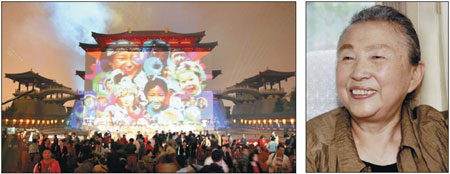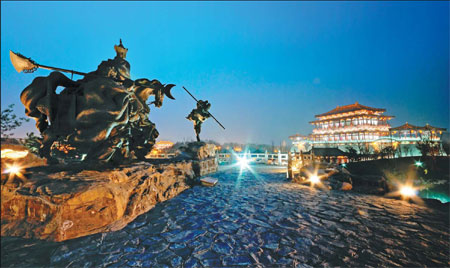Xi'an is believing
Updated: 2013-05-17 08:40
By Zhang Lei and Lu Hongyan (China Daily)
|
|||||||||||
|
Clockwise from top: After a complete restoration, Tang Paradise has become a major draw for tourists; Zhang Jinqiu from the Chinese Academy of Engineering undertook the general planning and construction design of Tang Paradise; the restored park not only recreates the original architecture designs, but adds modern touches such as waterscreen films. Provided to China Daily |

After 20 years of painstaking rebuilding that has paid heed to the past, the newly confident ancient capital is reaping the rewards
Who can blame a city with such a grand history for being ambitious? The ambition to lay down 13 railway lines under Xi'an and build dozens of stations over the next 27 years seems entirely apt for a city whose most famous credentials, its Terracotta Warriors, with their horses and chariots, were uncovered after a subterranean existence of 2,300 years.
But there is more to Xi'an than is happening underfoot. You barely need to raise your head to notice that the skyline of the ancient Chinese capital is cluttered with cranes, shooting up from dozens of construction sites along its crisscross roads. In fact many of those construction sites are linked with the subway work.
On many days of the year the cranes and everything beneath them wallow in a thick industrial smog that some jokingly reckon adds to the archaic feel of a city that is 3,000 years old. However, more serious souls are now looking for solutions to the problems of modernity and for ways to make Xi'an better reflect its origins, and there is no one who believes the task will be easy.
Those in charge of the planning largely agree that the city's development has to center on its ancient identity rather than modern skylines and landmarks. In this they nurse the hope that Xi'an will not end up being just another sprawling steel, glass and bitumen monument to city building.
"In an era of economic globalization, the similarities among different Chinese cities have overshadowed their true cultural value," says Duan Xiannian, deputy mayor of Xi'an and former director of Qujiang New District Administrative Committee.
"Without reverence for our ancestors, new construction in this city will simply produce soulless replicas. In turn, this disrespect will flow to the next generation, and it will become increasingly difficult for the city to find equilibrium between the environment and development."
In cultural terms, there is much more to Xi'an than the Terracotta Warriors. The city is abundant in cultural relics, including the ruins of four major imperial palaces from the Zhou (c. 11th century-771 BC), Qin (221-206 BC), Han (206 BC-AD 24) and Tang (AD 618-907) dynasties, and the tombs of 73 emperors.
However, most of those have been in a poor state of repair either because of a lack of money or mismanagement. And because large blocks of ruins are scattered over many districts, the city's development was been halting at best, particularly when it comes to roads, and the city has been notorious for its traffic jams.
In an effort to turn things around, almost 20 years ago the provincial government approved the establishment of Xi'an Qujiang New District, an area around the Tang Dynasty Big Wild Goose Pagoda, covering about 16 square kilometers, which was to be a holiday resort.
But it was only after what are now called Tang Paradise and Qujiang Pond Relic Park were completed, the first in 2005 and the second three years later, that the new districts established themselves in the public eye and brought about a fundamental change in the city's development patterns. The two areas had lain in ruins since the end of the Tang Dynasty, and rebuilding, based on designs described in ancient records, took nearly four years.
Four other relic parks have also been completed, but the work on none of the six could be regarded as restoration. Xue Xiangni, deputy director of the Culture Industrial Development Center at Qujiang Administrative Committee, says that the work produced theme parks allowing people in the area to have better access to history that otherwise would have been lost.
"We are not replicating history, but picking up the lost connection between the locals and the history embedded within."
Tang Paradise, covering 66 hectares, is to the north of the relics of the original Tang Dynasty Furong Garden, and includes museums, catering and Tang cultural entertainment.
Akiyama Ku, a Japanese master gardener, was responsible for designing the garden landscape. Zhang Jinqiu, of the Chinese Academy of Engineering, was responsible for general planning and construction design. In Tang Paradise, Zhang drew up designs for the gardens and palaces using her own interpretation of Tang architecture, and in architectural circles her works have been dubbed New Tang Style.
"There are three big things you really have to pay attention to with city planning in Xi'an. The first is the emphasis on ecological harmony and the second is a focus on historic and cultural inheritance. Without them the concept of city modernization cannot take root. The third is that in construction the materials you use need to be absolutely modern, relying on high technology. For Xi'an those three are a must," Zhang says.
Qujiang Pond Relic Park, where admission is free, and Tang Paradise, 500 meters away, where admission costs 80 yuan ($13; 10 euros), have spawned many services in the area.
The provincial Bureau of Statistics says the city's investment in fixed assets from January to February was 59.3 billion yuan, up 28.3 percent from the corresponding period last year, of which investment in services accounted for 38.7 billion yuan. Investment in fixed assets was 424.3 billion yuan last year, up 35 percent on the previous year. The figure, which ranked it 11th among major Chinese cities, is forecast to total 573 billion yuan this year.
Investment in fixed assets on a scale as large as that in Xi'an and other major cities generated about half of China's growth in the last decade, the Bureau of Statistics says.
If you are lucky enough to climb to the top of the Big Wild Goose Pagoda on a day when the air is clear, you get an uninterrupted view in all directions, seeing the perpetually snowcapped Mount Zhongnan about 40 kilometers away, and the surrounding pastoral landscape.
To the south is the New Tang style Tang Sleepless City covering 88 hectares, and which includes Shaanxi Modern Art Museum, Xi'an Opera Theater and open public areas that have become a drawcard for young people.
Xi'an Qujiang New District attracted domestic investment of 15.6 billion yuan last year, up nearly 21 percent on 2011, and foreign investment of $264 million, up nearly 26 percent.
Qujiang's approach follows the logic that the cultural heritage that lies within it embodies the city's memory, and it is on such memory that the two parks drew their influence and were built.
"In fact Xi'an's modernization is a process of cultural re-creation," says Suo Yangtao, deputy secretary-general of Shaanxi Chinese Culture Promotion Society.
"Besides those tangible cultural assets we have stored memories that are constantly being modified, edited and recreated."
Suo believes recreational activities rooted in the native culture will raise cultural awareness and economic development simultaneously.
"As for Tang Paradise, we didn't build it on the original spot, but a bit north of it, leaving the original ruins intact. Now everyone in Xi'an knows this area was a Tang imperial garden, where famous poets such as Li Bai and Bai Juyi gathered. They develop a sense of belonging to that artistic period while dining, sightseeing or shopping here. I see this as recreation drawing on cultural assets."
Hanyao Relic Park is themed on the love story of Wang Baochuan, a Tang Dynasty woman said to have spent 10 years in a cave waiting for her husband to return from battle. It opened to tourists in 2010, and Qujiang's core area was expanded to 52 sq km with more than nine hectares of public green space that is expected to stretch to nearly 1,000 hectares by 2020.
The district has become the green lung of the city, and average levels of PM 2.5 particularly hazardous pollution are notably lower than in other districts of the town.
Many probably think of Xi'an as first and foremost a cultural city, but in 2009 the city's cultural added value was put at only 14.9 billion yuan, one sixth that of Shanghai, and a quarter that of Shenzhen, which is often looked upon by many Chinese as a cultural desert because of how young it is.
By last year the estimate of Xi'an's cultural value had risen to 25.1 billion yuan.
Sun Xiguo, director of China Cultural Development Research Center at Peking University, says Xi'an needs to establish a pattern of development best suited to its needs, and what has been done in recent years seems to be bearing fruit.
Suo Yantao says the city will be able to draw maximum benefit from its cultural assets if they can all be linked to make a cohesive whole in people's minds.
"There is a difference between cultural resources and cultural wealth. A cultural asset evolves when you do certain things to make the public feel, experience and partake of your cultural resources in a spiritual way.
"Imagine you are standing on Qin Dynasty ruins surrounded by rubbish dumps, smelly city villages and farmlands. There is some great historic value there, but the public will fail to recognize its importance aesthetically and academically."
This was how things stood in Xi'an before the six relic parks of Qujiang were complete and a city with a refound past now looks as though it has a more sure future.
Last year Qujiang District had more than 45 million tourist visits, 12 million more than the year before and almost 10 times more than eight years earlier.
Between 2003 and 2011 turnover in tourism rose from 300 million to 2 billion.
"Now we are transforming our cultural relics from burdens on our shoulder to common wealth," Xue Xiangni says.
Contact the writers at zhanglei@chinadaily.com.cn and luhongyan@chinadaily.com.cn
(China Daily 05/17/2013 page16)
Today's Top News
List of approved GM food clarified
ID checks for express deliveries in Guangdong
Govt to expand elderly care
University asks freshmen to sign suicide disclaimer
Tibet gears up for new climbing season
Media asked to promote Sino-Indian ties
Shots fired at Washington Navy Yard
Minimum growth rate set at 7%
Hot Topics
Lunar probe , China growth forecasts, Emission rules get tougher, China seen through 'colored lens', International board,
Editor's Picks

|

|

|

|

|

|






